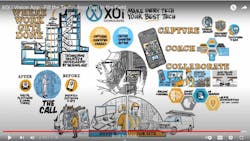Latest from Technology
Work Truck Week 2025 Welcomes More Than 16,000
Sponsored
When Ron Clark came on board at Newport News, VA-based Warwick Mechanical Group about a decade ago, he was tasked with making the mechanical contractor’s service division a profitable part of the business. At that time, with about 19 employees, the division was focused on serving the company’s construction division—making any repairs or replacements needed on equipment/systems installed by Warwick Mechanical.
“Whatever they built that wasn't working or needed, that's all the service division was doing,” notes Clark, Warwick’s vice president of services. “When I came on board, our main focus was new owner-direct clients. So we began to build a culture of best-in-class customer service, and that's what stuck, that’s how we got here.”
“Here” is a $15 million division with 50 technicians and about 20 office and support staff. Clark’s background in the controls side of the HVAC industry was mostly in sales management, and he used those people skills to work with the technicians and develop processes to make the service division more productive—and expand its customer base beyond its in-house “customers.”
Warwick’s plumbing and mechanical service techs are part of the UA Local 110 (Norfolk, Va.) or UA Local 10 (Richmond, Va.). With a union-based workforce, Clark had to ensure the company followed union guidelines while also instructing them how to serve customers the Warwick way.
“If I want that tech to take care of my customer the way I want him to, I need to take care of him, too,” he explains.
Warwick Mechanical focuses on commercial and industrial projects—military, the federal government, hospitals, educational facilities—throughout central Virginia and northeast North Carolina. Its total 2021 revenue was about $115 million.
A core value at the mechanical contracting firm is building relationships—with customers and employees. Last year, the 70-year-old contracting firm transformed itself into an employee-owned business through an employee stock ownership plan. And though the union techs are not considered Warwick employees because of union contracts, the company is invested in training them to increase their productivity and the division’s revenue.
Technical Help on the Job
“We didn’t have enough qualified technicians,” Clark notes. “We had technicians who were new to the industry and didn't have the skills we needed to grow the division.” If the more-experienced techs are unavailable, the only option is to send a less-seasoned tech to assess the situation. They may make numerous calls back to the office, or a supervisor may be needed at the jobsite to facilitate the repair.
So, Warwick Mechanical partnered with XOi Technologies and implemented its technician enablement solution to bridge the skills and equipment knowledge gap. The company started with a pilot program with a few technicians at the end of 2020, then expanded to all service techs in early 2021.
The software provides techs with the tools needed to accurately perform service tasks and satisfy internal and external customers. If techs get stuck by a particular jobsite problem, the cloud-based system allows techs to communicate with a supervisor through the mobile app and show exactly what they are working on.
“The supervisor sends a link via the app to the technician, who authorizes mobile app access to the supervisor,” Clark explains. “Now, the supervisor can see exactly what that tech is seeing.”
For even more tech assistance, the supervisor can take screenshots of the system or equipment and mark areas that need attention from the technician.
“I've seen a supervisor help troubleshoot a boiler—he takes a screenshot, circles it, and says to the tech, ‘See where I circled? Hit that,’ Or, ‘See this terminal I circled? Make sure you put the other wire to this,’” Clark explains. “In the meantime, it's all being recorded on the cloud.”
With remote support calling, newer technicians receive live, in-depth video training from a seasoned professional—helping to complete the job faster while improving their skills.
This eliminates sending a supervisor to a jobsite to troubleshoot a problem, saving time and increasing productivity for both service team members. And these “coaching sessions” are all recorded and stored in the database to be referenced for similar situations on other service calls.
“If a supervisor knows the tech doesn’t have an updated skill set for the job, he can say: ‘This is a chiller call. I know you're not a chiller guy yet, so when you get there, give me a call. I'll send you the link and walk you through it,’” Clark explains. “Sometimes, he still has to jump in the van and go help. But it's definitely a savings for us.”
In addition, the XOi platform contains nearly 200,000 manuals, diagrams, and wireframes from all major manufacturers. All uploaded content, photos, and videos can be readily accessed and managed in the Knowledge Base—this includes any additional content contractors may add to help their teams.
Warwick Mechanical also uses the platform in its onboarding process, Clark says.
“Along with defensive driving training and the required OSHA training, we assign new techs a few XOi videos to watch, and then we ask them questions about the procedure,” he explains. “It's a good onboarding tool for the newer guys. It's hard finding a seasoned technician who knows what he's doing, so we need to develop our own. This process is our way of getting new techs up to speed much quicker.”
Building Customer Trust
Another Warwick Mechanical core value is creating customer relationships by adding value to customer interactions.
“In our industry, trust is not where I think it should be,” Clark notes. “With XOI technology, a technician takes videos before, during and after the repair or replacement. He can share a link with the customer, who can see that the work was done as the technician said. It builds trust much quicker, especially with newer customers.”
That information, captured in real-time on the jobsite, also can be shared with decision-makers at a customer’s firm, especially when it comes time to renew a facility maintenance contract or service agreement. It maximizes customer value through efficiency, accuracy and accountability.
If preferred, customers also can send live videos of site conditions to Warwick to help diagnose the issue, provide better quotes and select the correct parts before the technician sets foot on the jobsite.
Clark adds that instead of writing job notes down and using other software, the XOi platform allows techs to record notes via voice command or video and sync with Warwick’s mobile invoicing software. So all the jobsite information is linked to the service ticket.
The technology also is useful for the sales team.
“A salesperson can go out to a job, videotape the situation and how he or she thinks it's going to go,” Clark explains. “The salesperson approaches the customer and says, ‘OK, I'm replacing this part or piece of equipment for this much,’ and the customer agrees. The link is shared with the install team; they can see what they’re going to be doing before they even get to the jobsite.”
The XOi platform includes a workflow that sales staff can use to document equipment and systems as they survey the site for preventative maintenance agreements. When a tech arrives for the annual maintenance, he already knows what needs to be done and where he needs to go. That confidence gives customers peace of mind and helps build the trust necessary for repeat customers.
Kelly Faloon is a contributing writer to Contractor magazine and principal of Faloon Editorial Services. The former editor of Plumbing & Mechanical magazine, she has more than 20 years of experience in the plumbing and heating industry and more than 30 years in B2B publishing. Faloon is a journalism graduate of Michigan State University.

Kelly L. Faloon | Freelance Writer/Editor
Kelly L. Faloon is a contributing editor and writer to Contractor, Contracting Business magazine and HPAC Engineering and principal of Faloon Editorial Services. The former editor of Plumbing & Mechanical magazine, Faloon has more than 26 years of experience in the plumbing and heating industry and more than 35 years in B2B publishing. She started a freelance writing and editing business in 2017, where she has a varied clientele.
Faloon spent 3 1/2 years at Supply House Times before joining the Plumbing & Mechanical staff in 2001. Previously, she spent nearly 10 years at CCH/Wolters Kluwer, a publishing firm specializing in business and tax law, where she wore many hats — proofreader, writer/editor for a daily tax publication, and Internal Revenue Code editor.
A native of Michigan’s northern Lower Peninsula, Faloon is a journalism graduate of Michigan State University. You can reach her at [email protected].




